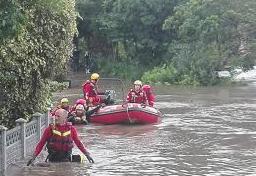What to do during a power outage

What to do during a power outage
First, check whether the power outage is limited to your home. If your neighbours' power is still on, check your own circuit breaker panel or fuse box. If the problem is not a breaker or a fuse, check the service wires leading to the house. If they are obviously damaged or on the ground, stay at least 10 meters back and notify your electric supply authority. Keep the number along with other emergency numbers near your telephone.
If your neighbours' power is also out, notify your electric supply authority. Turn off all tools, appliances and electronic equipment, and turn the thermostat(s) for the home heating system down to minimum to prevent damage from a power surge when power is restored. Also, power can be restored more easily when there is not a heavy load on the electrical system.
Turn off all lights, except one inside and one outside, so that both you and hydro crews outside know that power has been restored.
Don't open your freezer or fridge unless it is absolutely necessary. A full freezer will keep food frozen for 24 to 36 hours if the door remains closed.
Never use charcoal or gas barbecues, camping heating equipment, or home generators indoors or in garages. They give off carbon monoxide. Because you can't smell or see it, carbon monoxide can cause health problems and is life-threatening.
Use proper candle holders. Never leave lit candles unattended and keep out of reach of children. Always extinguish candles before going to bed.
Listen to your battery-powered or wind-up radio for information on the outage and advice from authorities.
Tips:
Make sure your home has a working carbon monoxide detector. If it is hard-wired to the house's electrical supply, ensure it has a battery-powered back-up.
Protect sensitive electrical appliances such as TVs, computer, and DVD players with a surge-protecting powerbar.
Use of home generators
Home generators are handy for backup electricity in case of an outage, but must only be used in accordance with the manufacturer's guidelines. A back-up generator may only be connected to your home's electrical system through an approved transfer panel and switch that has been installed by a qualified electrician. Never plug a generator into a wall outlet as serious injury can result when the current produced by the home generator is fed back into the electrical lines, and transformed to a higher voltage. This can endanger the lives of utility employees working to restore the power.
To operate a generator safely:
Follow the manufacturer's instructions.
Ensure that the generator operates outdoors in well-ventilated conditions, well away from doors or windows, and never in your garage, to prevent exhaust gases from entering the house.
Connect lights and appliances directly to the generator. If extension cords must be used, ensure they are properly rated, CSA-approved cords.
If you have to evacuate
Evacuation is more likely during winter months, when plummeting temperatures can make a house inhabitable. Although a house can be damaged by low temperatures, the major threat is to the plumbing system. If a standby heating system is used, check to see that no part of the plumbing system can freeze.
If the house must be evacuated, protect it by taking the following precautions:
Turn off the main breaker or switch of the circuit-breaker panel or power-supply box.
Turn off the water main where it enters the house. Protect the valve, inlet pipe, and meter or pump with blankets or insulation material.
Drain the water from your plumbing system. Starting at the top of the house, open all taps, and flush toilets several times. Go to the basement and open the drain valve.
Drain your hot water tank by attaching a hose to the tank drain valve and running it to the basement floor drain.
Note: If you drain a gas-fired water tank, the pilot light should be turned out - call the local gas supplier to re-light it.
Unhook washing machine hoses and drain.
Do not worry about small amounts of water trapped in horizontal pipes. Add a small amount of glycol or antifreeze to water left in the toilet bowl, and the sink and bathtub traps.
If your house is protected from groundwater by a sump pump, clear valuables from the basement floor in case of flooding.


